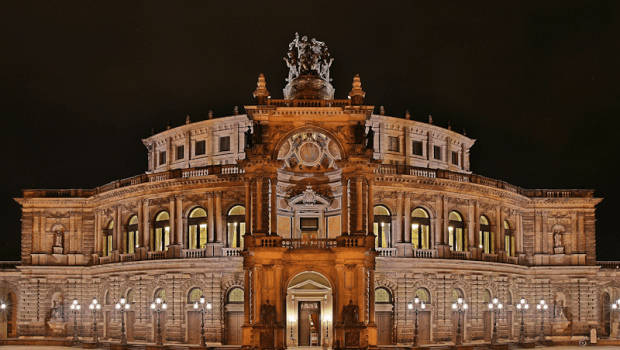
The opera house located on the river Elbe, placed within Germany’s historic city – Dresden, is the Semperoper. Originally the opera hall was conceived in the year 1841 by the architect Gottfried Semper. The Semperoper comprises of Sächsische Staatsoper Dresden or the Saxon State Opera and the concert hall of the Staatskapelle Dresden or the Saxon State Orchestra. This opera hall also includes the Semperoper ballet. Richard Wagner and Richard Strauss were among the most well renowned composers whose operas premiered at the Semperoper.
At any given day you can witness the magnificence of this structure dominating the Theaterplatz next to the Elbe. All these constructions put together form the centrepiece of the old historic city. The designs of Gottfried Semper carried a confluence of two main styles which came to be known as the late Classical style and the Renaissance elements.
Semperoper has always been a matter of pride for the people of Dresden. It is only because of the people that the Semperoper stands tall and glorified, surviving a devastating fire in 1869 and the bombing of Dresden in the last months of the War.
History
The predecessor to today’s Semperoper was the Opernhaus am Zwinger. It was present from 1719 and 1849. This building was well equipped to house up to 2000 guests.
Gottfried Semper, an architect was the one responsible for what Semperoper looks like today. Though the initial design changed at the time of the various reconstruction process, however, the essential design remained the same. With the completion of Semperoper, its opening ceremony was conducted on the 13th of April 1841 with an opera conducted by Carl Maria von Weber. Thus the most beautiful European opera hall was born.
The architectural design of the building and its stylisation has been a matter of debate among many. Semperoper carries features and influences from three proper styles such as: Early Renaissance and Baroque, with Corinthian style pillars which hold topicalities from the period belonging to the Greek classical revival. Eclecticism is a suitable terms which best describes the confluence of the above mentioned styles. This practice was also quite common during this time period. These configurations have enabled the Semperoper to attain the status of being the most popular and beautiful opera house building in the whole of Europe.
The Semperoper in 1869 suffered complete devastation at the hands of the fire. If it were not for the people of Dresden the Semperoper would have been left to ruins. The people went on immediately rebuilding the damaged sections of the building. Moreover, they also posed requests to Gottfried Semper himself to assist in the reconstruction process. Gottfried Semper at that point in time was living in exile because he was accused of being associated with the May 1849 uprising in Dresden.
Construction on an interim Theater am Zwinger began just about a month after the disaster caused at the hands of the fire. This theatre was located right behind the ruins of the ruins of the old opera hall. The construction process lasted a total of six weeks. As a result of this a venue was created which could house 1800 visitors. Here, at the opening night on 2nd December, 1869 Goethe’s Iphigenie auf Tauris was performed.
When Gottfried Semper was abroad in exile he created some of the marvels such as the Vienna Burgtheater. Semper was indeed involved in the second construction while he was still away. This new construction was headed by Sempers son, Manfred Semper who took his father’s plans and modulated them to construct the opera hall which was completed in the year 1878. This particular opera hall was built under the neo-renaissance impressions. Moreover, as the construction process was going on, certain performances such as the Gewerbehaussaal was held in the year 1870.
Magnificent was the one word which was as if labelled on all the observers tongues. On the inside intricate work was conducted. There were ceiling paintings, frieze situated above the proscenium where performances were conducted. All of them were created under the direction of Semper James Marshall. However, this marvel too fell but this time at the hands of the corrosive destruction of World War II.
The Semperoper is also regarded to be the epitome of Dresden’s Baroque architectural stylisation. This opera hall is located right on the Theatre Square within the central region of the city which is located on the banks of the river Elbe. A Panther quadriga along with a stature of Dionysus was placed on the top of the portal. Architects such as Johannes Schilling were responsible for the designing and the creation of the interior section of the opera hall. Furthermore, the monuments which are located on the portal depict famous artists such as – Johann Wolfgang von Goethe, Friedrich Schiller, William Shakespeare, Sophocles, Molière and Euripides. Ernst Rietschel and Ernst Julius Hähnel are among the few artists whose works can be witnessed in the building.
During the initial times of the Semperoper, basically during the pre-war days, Richard Strauss’s many works were premiered. Towards the end of the World War II, during the last few months, the building again fell because of the carnage caused by the bombing of Dresden and the many firestorms that followed. After this hell came to an end, the many observers have noted that only the skeleton of the building remained. That is, only the exterior shell of the building remained and nothing else. Furthermore, it was precisely after a time period of 40 years, on the 13th of February in 1985 that the opera house reached its completion. The planners and designers made it sure that the appearance of the building remains precisely the same as it was before the destruction of the war took it down. The rebuilding processed resulted in an almost replication. This time the new additions included a modern rear service building and modern stage machinery. At the time of the opening, the first opera that was performed was Carl Maria von Weber’s Der Freischütz. The Der Freischütz was in-fact the last opera that was presented before Semperpers destruction in 1945.
Three years after the war ended, since 1948 in-facr the role of the opera hall was performed by the Great House of the State Theatre. Here ballets, operas, dramas and Staatskapelle continued. At the time of the opening ceremony on the 22nd of September, 1948 Beethoven’s Fidelio was performed. In the year 1983, the State Theatre and the State Opera Dresden was created because of an administrative separation of opera, ballet, Staatskapelle and the drama. Moreover, on the 13th of February 1985 the Semperoper opera building was resurrected back to life.
This time of-course the construction was based on the original plans of Semper but the chief architect was Wolfgang Hänsch. Attached to the main building of the opera hall was another rebuilding with all the modern facilities. This building was ideated to be used as a rehearsal centre, along with being a functional building and an administrative centre. It was connected with the opera house using a number of bridges.
On the façade of the opera hall you can find four numbers of masks made in sandstone by Peter Makolies. These masks were manufactured between 1982 and 1984, and carry dimensions – 2.7 metres by 5.2 metres.
It was on the 40th anniversary of the Wartime destruction that marked a performance in the opera hall. On the 13th of February, 1985 at the Semperoper Carl Maria von Weber’s opera Der Freischütz was performed.
With the new millennium coming about the building in 2002 suffered heavy damage due to the flooding of the Elbe. This time help came from all over the world for the purposes of repairs and fixations. The Dresden Opera Ball came to life marking the 800th year celebration of the city of Dresden in 2008. This has become an annual affair since then.
The orchestra which is today used most often during operas is the Sächsische Staatskapelle Dresden.
The most popular artists who have been associated with Semperoper include the following:
- Carl Gottlieb Reißiger
- Richard Wagner
- Ernst von Schuch
- Fritz Reiner
- Fritz Busch
- Karl Böhm
- Karl Elmendorff
- Joseph Keilberth
- Rudolf Kempe
- Otmar Suitner
- Kurt Sanderling
- Herbert Blomstedt
- Hans Vonk
- Giuseppe Sinopoli
- Semyon Bychkov
- Bernard Haitink
- Fabio Luisi
- Christian Thielemann
- Bernd Aldenhoff
- Elisabeth Höngen
- Friedrich Plaschke
- Elisabeth Rethberg
- Ernestine Schumann-Heink
- Erna Sack
- Richard Tauber
- Tino Pattiera
- Meta Seinemeyer
- Margarethe Siems
- Therese Malten
- Edda Moser
- Minnie Nast
- Eva von der Osten
- Hermann Wedekind
- Marie Wittich
- Polina Semionova
Following is a list of the operas that have been premiered at Semperoper:
- 1842: Wagner – Rienzi,
- 1843: Wagner – The Flying Dutchman,
- 1845: Wagner – Tannhäuser,
- 1895: Eugen d’Albert: Ghismonda,
- 1901: Richard Strauss – Feuersnot,
- 1905: Richard Strauss – Salome,
- 1909: Richard Strauss – Elektra,
- 1911: Richard Strauss – Der Rosenkavalier,
- 1913: Ermanno Wolf-Ferrari – L’amore medico,
- 1916: Eugen d’Albert – Die toten Augen,
- 1917: Hans Pfitzner – Das Christ-Elflein,
- 1924: Richard Strauss – Intermezzo,
- 1925: Ferruccio Busoni – Doktor Faust,
- 1926: Kurt Weill – Der Protagonist,
- 1926: Paul Hindemith – Cardillac,
- 1927: Emil von Reznicek – Spiel oder Ernst
- 1927: Othmar Schoeck – Penthesilea,
- 1928: Richard Strauss – Die ägyptische Helena,
- 1930: Othmar Schoeck – Vom Fischer and syner Fru,
- 1932: Eugen d’Albert – Mr Wu
- 1933: Richard Strauss – Arabella,
- 1935: Richard Strauss – Die schweigsame Frau,
- 1935: Rudolf Wagner-Régeny – Der Günstling,
- 1937: Othmar Schoeck – Massimilla Doni,
- 1938: Richard Strauss – Daphne,
- 1940: Heinrich Sutermeister – Romeo und Julia,
- 1942: Heinrich Sutermeister – Die Zauberinsel,
- 1944: Gottfried von Einem – Prinzessin Turandot,
- 1944: Joseph Haas – Die Hochzeit des Jobs,
- 1985: Siegfried Matthus – Die Weise von Liebe und Tod des Cornets Christoph Rilke,
- 1989: Eckehard Meyer – Der goldene Topf,
- 1998: Matthias Pintscher – Thomas Chatterton,
- 2001: Peter Ruzicka – Celan,
- 2008: Manfred Trojahn – La grande magia,
- 2010: Hans Werner Henze – Gisela (Dresden version),
- 2011: Miroslav Srnka – Jakub Flügelbunt ,
- 2012: Johannes Wulff-Woesten – Die Konferenz der Tiere,
- 2013: Johannes Wulff-Woesten – Prinz Bussel,
Following are the details concerning the opening hours of the box office and contact information for ticketing purposes.
Ticket counters can be found between Zwinger and Hofkirche in the Schinkelwache/Theaterplatz.
The address is as follows: Semperoper Dresden / Saxon State Opera Dresden
Vertrieb & Service
Theaterplatz 2
01067 Dresden
